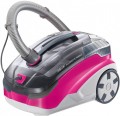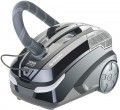Compatible bags (dust collectors)
Models of replacement bags and/or other containers for waste (see "Dust collector") with which the vacuum cleaner is compatible.
This moment does not affect the functionality of the vacuum cleaner itself. However, knowing the model of the dust collector makes it much easier to find a spare or replacement dust collector. At the same time, we note that compatible models of such containers may differ markedly in specifications from the ones in the box. For example, many fabric bag vacuum cleaners also accept disposable paper bags; and some units are initially equipped with a dust collector of one type. However, if desired, they allow you to buy and install a dust collector of another type (for example, replace the bag with an aquafilter).
Compatible HEPA filters
Models of HEPA filters that are suitable for installation in a vacuum cleaner.
This information is needed mainly to find new filters to replace clogged or worn ones. Theoretically, knowing the HEPA model you can find detailed data about it. However, such details are usually not required; information on the fine filter class is enough to select a vacuum cleaner.
Noise level
The noise level produced by the vacuum cleaner during operation. Usually, the value for normal operation at maximum engine power is indicated here. With less power, the loudness of the unit may be lower, but the key is precisely the maximum indicator.
Regarding specific numbers, keep in mind that the decibel used to measure the noise level is a non-linear quantity. Therefore, it is worth evaluating specific indicators using special comparative tables. In general, vacuum cleaners are quite noisy appliances; so in this case, models are considered quiet if this indicator
does not exceed 65 dB — this is the level of a loud conversation between 2 – 3 people at a distance of 1 m. The quietest of these models give out only 40 dB — this is the average volume of a person’s speech in normal tones (and the minimum volume allowed for constant noise sources in living quarters during the day). For louder units, the comparison table looks like this:
—
66 – 70 dB — loud conversations between several groups of people at a distance of about 1 m;
—
71 – 75 dB — the volume of a cry or laughter in full voice at a distance of about 1 m;
—
76 – 80 dB — the volume of a mechanical alarm clock or the engine of an old truck;
—
more than 80 dB — a very high noise level, exceeding the level of a loud scr
...eam; when working with a vacuum cleaner having such specifications for a long time, it is highly desirable to use hearing protection.
Also note that the noise level largely depends on the engine power, as well as some other features (for example, it is strongly affected by the presence of an aquafilter — see "Dust collector"). At the same time, there is no hard connection here, and units with a similar set of specifications can differ markedly in actual loudness. In such cases, when choosing here, it is worth proceeding from the fact that a quieter vacuum cleaner will be more comfortable to use. However, it will most likely cost noticeably more.
